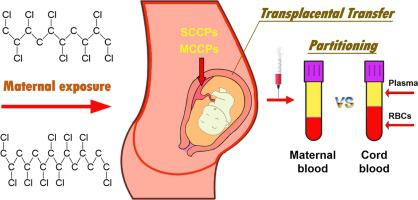Environment International ( IF 10.3 ) Pub Date : 2020-06-23 , DOI: 10.1016/j.envint.2020.105871 Hui Chen 1 , Wei Zhou 2 , James C W Lam 3 , Jiali Ge 2 , Juan Li 2 , Lixi Zeng 2

|
As a new group of persistent organic pollutants of concern, chlorinated paraffins (CPs) have been widely detected in the environment and biota, but their occurrence, partitioning, and transfer in humans have been not well documented. In this study, 32 pairs of maternal blood, cord blood, and placenta samples were collected from pregnant women in South China, and the blood was further separated into plasma and red blood cells (RBCs) for blood partitioning study. Short- and medium-chain CPs (SCCPs and MCCPs, respectively) were detected in all the five human biological matrices, suggesting prevalent exposure and maternal transfer of CPs in the pregnant women. Discrepant congener group profiles of CPs were observed in different human biological matrices. Significant differences in the plasma-RBC partitioning of CPs in the maternal and cord bloods were identified (p < 0.001). CP partitioning to plasma was stronger than that to RBCs in maternal blood, but the converse was true for cord blood. Mass fractions in plasma (Fp) for SCCPs (mean, 0.78) and MCCPs (0.74) in maternal blood were significantly higher than the values in cord blood. Transplacental transfer efficiencies (TTEs) were evaluated based on the whole blood concentrations of CPs in the maternal and cord bloods, and the TTEs ranged from 0.50 to 0.69 (first to third quartiles) for SCCPs and MCCPs, indicating that the placenta can partially restrict maternal transfer. The extent of CP retention in the placenta was assessed by the concentration ratio (RPM) of matched placenta and maternal blood, and interestingly, a U-shaped trend for placental retention (RPM) with increasing chain length was observed for individual congener groups. Significant relationships of the CP concentrations among the maternal blood, cord blood, and placenta were observed (p < 0.001). To our knowledge, this is the first study to report the plasma-RBC partitioning of CPs in human maternal and cord bloods, as well as the first study to evaluate TTEs based on whole blood concentrations. Our study confirmed that whole blood is the preferred matrix for accurately assessing human internal exposure and transplacental transfer of CPs.
中文翻译:

来自华南地区母婴对中氯化石蜡的血液分配和全血母体转移评估。
作为关注的一类新的持久性有机污染物,氯化石蜡(CPs)已在环境和生物区系中被广泛检测到,但是它们在人体内的发生,分配和转移尚未得到充分记录。在这项研究中,从华南地区的孕妇那里采集了32对产妇的血液,脐带血和胎盘样本,并将这些血液进一步分为血浆和红细胞(RBC)进行血液分配研究。在所有五个人类生物基质中均检测到短链和中链CP(分别为SCCP和MCCP),这表明孕妇中CP的普遍暴露和母体转移。在不同的人类生物学基质中观察到CP的同类同族群概况。p <0.001)。CP在血浆中的分配要强于血浆中的RBC,但对于脐带血则相反。母血中短链氯化石蜡的血浆质量分数(F p)(平均值为0.78)和多氯联苯酚的血浆质量分数(F p)显着高于脐带血的质量分数(F p)(0.74)。根据母体和脐带血中CP的全血浓度评估胎盘转运效率(TTE),SCCP和MCCP的TTE范围从0.50至0.69(第一至第三四分位数),表明胎盘可以部分限制母体转让。CP在胎盘中的保留程度通过浓度比(R PM)匹配的胎盘和母体血液,有趣的是,观察到单个同类人群的胎盘滞留(R PM)呈U型趋势,链长增加。观察到母体血液,脐带血和胎盘中CP浓度之间的显着关系(p <0.001)。据我们所知,这是第一项报告人母血和脐带血中CP的血浆-RBC分配的研究,也是第一项基于全血浓度评估TTE的研究。我们的研究证实,全血是准确评估人体内部暴露和CP的经胎盘转移的首选基质。











































 京公网安备 11010802027423号
京公网安备 11010802027423号